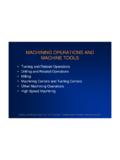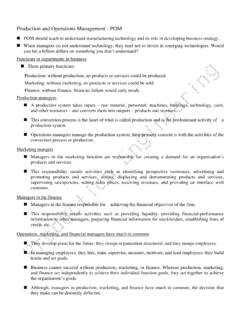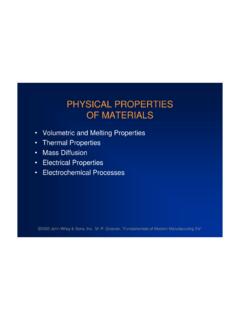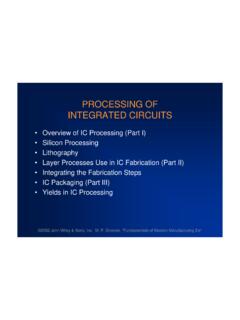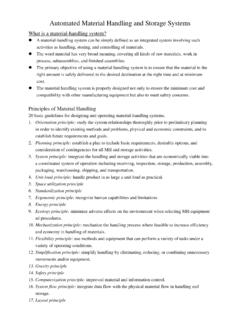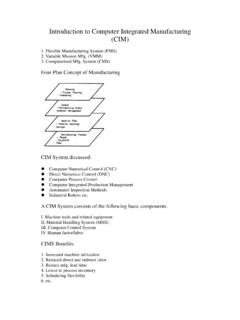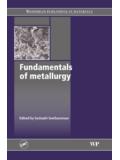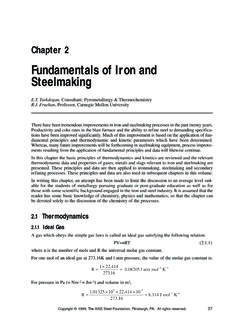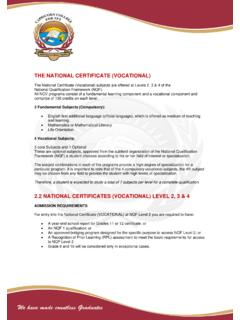Transcription of POWDER METALLURGY - 國立中興大學
1 2002 John Wiley & Sons, Inc. M. P. Groover, fundamentals of Modern Manufacturing 2/e POWDER METALLURGY The Characterization of Engineering Powders Production of Metallic Powders Conventional Pressing and Sintering Alternative Pressing and Sintering Techniques Materials and Products for PM Design Considerations in POWDER METALLURGY 2002 John Wiley & Sons, Inc. M. P. Groover, fundamentals of Modern Manufacturing 2/e POWDER METALLURGY (PM)Metal processing technology in which parts areproduced from metallic powders In the usual PM production sequence, the powdersare compressed (pressed) into the desired shape andthen heated (sintered) to bond the particles into ahard, rigid mass Pressingis accomplished in a press-type machineusingpunch-and-dietooling designed specificallyfor the part to be manufactured Sinteringis performed at a temperature below themelting point of the metal 2002 John Wiley & Sons, Inc. M. P. Groover, fundamentals of Modern Manufacturing 2/e Why POWDER METALLURGY is Important PM parts can be mass produced tonet shapeornearnet shape, eliminating or reducing the need forsubsequent machining PM process wastes very little material-about 97% ofthe starting powders are converted to product PM parts can be made with a specified level ofporosity, to produce porous metal parts Examples: filters, oil-impregnated bearings andgears 2002 John Wiley & Sons, Inc.
2 M. P. Groover, fundamentals of Modern Manufacturing 2/e More Reasons Why PM is Important Certain metals that are difficult to fabricate by othermethods can be shaped by POWDER METALLURGY Example: Tungsten filaments for incandescentlamp bulbs are made by PM Certain alloy combinations and cermets made by PMcannot be produced in other ways PM compares favorably to most casting processes indimensional control PM production methods can be automated foreconomical production 2002 John Wiley & Sons, Inc. M. P. Groover, fundamentals of Modern Manufacturing 2/e Limitations and Disadvantageswith PM Processing High tooling and equipment costs Metallic powders are expensive Problems in storing and handling metal powders Examples: degradation over time, fire hazardswith certain metals Limitations on part geometry because metal powdersdo not readily flow laterally in the die during pressing Variations in density throughout part may be aproblem, especially for complex geometries 2002 John Wiley & Sons, Inc.
3 M. P. Groover, fundamentals of Modern Manufacturing 2/e PM Work Materials Largest tonnage of metals are alloys of iron, steel,and aluminum Other PM metals include copper, nickel, andrefractory metals such as molybdenum and tungsten Metallic carbides such as tungsten carbide are oftenincluded within the scope of POWDER METALLURGY 2002 John Wiley & Sons, Inc. M. P. Groover, fundamentals of Modern Manufacturing 2/e Figure collection of POWDER METALLURGY parts (courtesy ofDorstAmerica, Inc.) 2002 John Wiley & Sons, Inc. M. P. Groover, fundamentals of Modern Manufacturing 2/e Engineering PowdersApowdercan be defined as a finely divided particulatesolid Engineering powders include metals and ceramics Geometric features of engineering powders: Particle size and distribution Particle shape and internal structure Surface area 2002 John Wiley & Sons, Inc. M. P. Groover, fundamentals of Modern Manufacturing 2/e Measuring Particle Size Most common method uses screens of differentmesh sizes Mesh count-refers to the number of openings perlinear inch of screen A mesh count of 200 means there are 200openings per linear inch Since the mesh is square, the count is the same inboth directions, and the total number of openingsper square inch is 2002= 40,000 Higher mesh count means smaller particle size 2002 John Wiley & Sons, Inc.
4 M. P. Groover, fundamentals of Modern Manufacturing 2/e Figure mesh for sorting particle sizes 2002 John Wiley & Sons, Inc. M. P. Groover, fundamentals of Modern Manufacturing 2/e Figure of the possible (ideal) particle shapes inpowder METALLURGY 2002 John Wiley & Sons, Inc. M. P. Groover, fundamentals of Modern Manufacturing 2/e Interparticle Friction andFlow Characteristics Friction between particles affects ability of a powderto flow readily and pack tightly A common test of interparticle friction is theangle ofrepose, which is the angle formed by a pile ofpowders as they are poured from a narrow funnel 2002 John Wiley & Sons, Inc. M. P. Groover, fundamentals of Modern Manufacturing 2/e Figure friction as indicated by the angle of reposeof a pile of powders poured from a narrow funnel. Larger anglesindicate greater interparticle friction. 2002 John Wiley & Sons, Inc. M. P. Groover, fundamentals of Modern Manufacturing 2/e Observations Smaller particle sizes generally show greater frictionand steeper angles Spherical shapes have the lowestinterparticalfriction As shape deviates from spherical, friction betweenparticles tends to increase 2002 John Wiley & Sons, Inc.
5 M. P. Groover, fundamentals of Modern Manufacturing 2/e Particle Density Measures True density-density of the true volume of thematerial The density of the material if the powders weremelted into a solid mass Bulk density-density of the powders in the loosestate after pouring Because of pores between particles, bulk densityis less than true density 2002 John Wiley & Sons, Inc. M. P. Groover, fundamentals of Modern Manufacturing 2/e Packing Factor = Bulk Densitydivided by True Density Typical values for loose powders range between If powders of various sizes are present, smallerpowders will fit into the interstices of larger ones thatwould otherwise be taken up by air, thus higherpacking factor Packing can be increased by vibrating the powders,causing them to settle more tightly Pressure applied during compaction greatlyincreases packing of powders through rearrangementand deformation of particles 2002 John Wiley & Sons, Inc. M.
6 P. Groover, fundamentals of Modern Manufacturing 2/e PorosityRatio of the volume of the pores (empty spaces) in thepowder to the bulk volume In principle, Porosity + Packing factor = The issue is complicated by the possible existence ofclosed pores in some of the particles If internal pore volumes are included in aboveporosity, then equation is exact 2002 John Wiley & Sons, Inc. M. P. Groover, fundamentals of Modern Manufacturing 2/e Chemistry and Surface Films Metallic powders are classified as either Elemental-consisting of a pure metal Pre-alloyed-each particle is an alloy Possible surface films include oxides, silica,adsorbed organic materials, and moisture As a general rule, these films must be removedprior to shape processing 2002 John Wiley & Sons, Inc. M. P. Groover, fundamentals of Modern Manufacturing 2/e Production of Metallic Powders In general, producers of metallic powders are not thesame companies as those that make PM parts Virtually any metal can be made into POWDER form Three principal methods by which metallic powdersare commercially In addition, mechanical methods are occasionallyused to reduce POWDER sizes 2002 John Wiley & Sons, Inc.
7 M. P. Groover, fundamentals of Modern Manufacturing 2/e Gas Atomization MethodHigh velocity gas stream flows through an expansionnozzle, siphoning molten metal from below andspraying it into a container Droplets solidify into POWDER formFigure (a) gasatomization method 2002 John Wiley & Sons, Inc. M. P. Groover, fundamentals of Modern Manufacturing 2/e Figure powders produced by decomposition of ironpentacarbonyl; particle sizes range from about microns(10 to 125 -in) (photo courtesy of GAF Chemicals Corporation,Advanced Materials Division) 2002 John Wiley & Sons, Inc. M. P. Groover, fundamentals of Modern Manufacturing 2/e Conventional Press and Sinter After the metallic powders have been produced, theconventional PM sequence consists of three the into desired part to a temperature below themelting point to cause solid-state bonding ofparticles and strengthening of part In addition, secondary operations are sometimesperformed to improve dimensional accuracy,increase density, and for other reasons 2002 John Wiley & Sons, Inc.
8 M. P. Groover, fundamentals of Modern Manufacturing 2/e Figure POWDER METALLURGY production sequence:(1) blending, (2) compacting, and (3) sintering; (a) shows thecondition of the particles while (b) shows the operation and/orworkpart during the sequence 2002 John Wiley & Sons, Inc. M. P. Groover, fundamentals of Modern Manufacturing 2/e Blending and Mixing of Powders For successful results in compaction and sintering,the starting powders must be homogenized Blending-powders of the same chemistry butpossibly different particle sizes are intermingled Different particle sizes are often blended to reduceporosity Mixing-powders of different chemistries arecombined PM technology allows mixing various metals intoalloys that would be difficult or impossible toproduce by other means 2002 John Wiley & Sons, Inc. M. P. Groover, fundamentals of Modern Manufacturing 2/e CompactionApplication of high pressure to the powders to formthem into the required shape The conventional compaction method ispressing, inwhich opposing punches squeeze the powderscontained in a die The workpart after pressing is called agreencompact, the word green meaning not yet fullyprocessed Thegreen strengthof the part when pressed isadequate for handling but far less than after sintering 2002 John Wiley & Sons, Inc.
9 M. P. Groover, fundamentals of Modern Manufacturing 2/e Figure in PM: (1) filling die cavity with POWDER byautomatic feeder; (2) initial and (3) final positions of upper andlower punches during pressing, and (4) ejection of part 2002 John Wiley & Sons, Inc. M. P. Groover, fundamentals of Modern Manufacturing 2/e Figure 450 kN(50-ton) hydraulicpress for compactionof POWDER metallurgycomponents. Thispress has thecapability to actuatemultiple levels toproduce complex PMpart geometries (photocourtesyDorstAmerica, Inc.). 2002 John Wiley & Sons, Inc. M. P. Groover, fundamentals of Modern Manufacturing 2/e SinteringHeat treatment to bond the metallic particles, therebyincreasing strength and hardness Usually carried out at between 70% and 90% of themetal's melting point (absolute scale) Generally agreed among researchers that theprimary driving force for sintering is reduction ofsurface energy Part shrinkage occurs during sintering due to poresize reduction 2002 John Wiley & Sons, Inc.
10 M. P. Groover, fundamentals of Modern Manufacturing 2/e Figure on a microscopic scale: (1) particlebonding is initiated at contact points; (2) contact points growinto"necks"; (3) the pores between particles are reduced in size; and(4) grain boundaries develop between particles in place of thenecked regions 2002 John Wiley & Sons, Inc. M. P. Groover, fundamentals of Modern Manufacturing 2/e Figure (a) Typical heat treatment cycle in sintering; and(b) schematic cross-section of a continuous sintering furnace 2002 John Wiley & Sons, Inc. M. P. Groover, fundamentals of Modern Manufacturing 2/e Densification and SizingSecondary operations are performed to increasedensity, improve accuracy, or accomplish additionalshaping of the sintered part Repressing-pressing the sintered part in a closeddie to increase density and improve properties Sizing-pressing a sintered part to improvedimensional accuracy Coining-pressworking operation on a sintered partto press details into its surface Machining-creates geometric features that cannotbe achieved by pressing, such as threads, side holes,and other details 2002 John Wiley & Sons, Inc.

